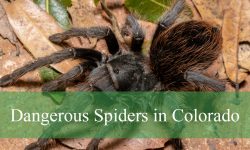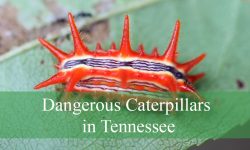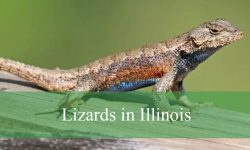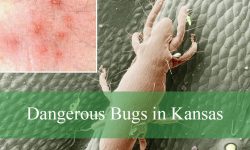Across Wyoming’s wide-open skies, hawks reign as some of the most impressive and adaptable birds of prey. Their keen eyesight, powerful talons, and soaring abilities make them both efficient hunters and iconic figures in the state’s landscapes. From vast prairies to rugged mountain ranges, these raptors thrive in a variety of habitats.
Each species of hawk in Wyoming has its own distinct traits, behaviors, and ecological roles. Some are year-round residents that claim territories and raise their young here, while others migrate through, stopping to hunt and rest before continuing long journeys. This diversity makes Wyoming a haven for birdwatchers and wildlife enthusiasts alike.
Understanding the hawks of Wyoming involves more than just spotting them in flight. It includes recognizing their physical features, observing their hunting styles, and learning about the environments that support their survival. In this guide, we’ll explore eleven types of hawks found in the state, with detailed identification tips, behaviors, and fun facts to enhance your birding experience.
Different Types of Hawks Found in Wyoming
Red-tailed Hawk
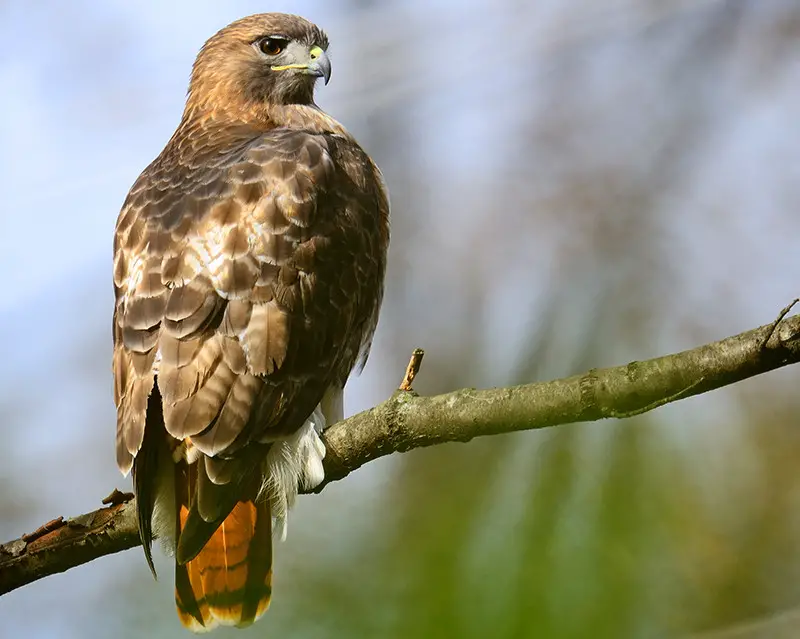
The Red-tailed Hawk is one of the most widespread raptors in North America and is a common sight across Wyoming’s open landscapes. This large bird of prey has a body length of 18 to 26 inches, a wingspan ranging from 43 to 57 inches, and weighs between 1.5 to 3.5 pounds depending on sex, with females being larger. Its most distinctive feature is the rich, brick-red tail seen in adults, contrasting with its pale underparts and dark mottling on the belly known as the “belly band.” Juveniles lack the red tail, instead showing a brownish-gray one, which helps in age identification.
Behaviorally, Red-tailed Hawks are known for their impressive soaring abilities, often circling high in the sky while scanning for prey. They are highly territorial and will defend their nesting areas aggressively, especially during the breeding season. Courtship flights involve dramatic aerial displays, including steep dives and spirals. These hawks often perch on fence posts, utility poles, or trees near open fields, giving birdwatchers in Wyoming ample opportunities to observe them.
Their diet primarily consists of small mammals such as voles, rabbits, and squirrels, although they also take birds, reptiles, and carrion when available. They are opportunistic hunters that rely on keen eyesight to detect movement from great distances before swooping down in swift, powerful dives. Red-tailed Hawks play an essential role in controlling rodent populations, which makes them a vital predator within Wyoming’s ecosystems.
Breeding begins in early spring, with pairs building large stick nests in tall trees, cliffs, or even human-made structures. Clutch size usually ranges from one to four eggs, which are incubated for about a month. Both parents participate in feeding the young until they fledge after six to seven weeks. In Wyoming, they inhabit open fields, prairies, sagebrush plains, and forest edges, thriving in the state’s diverse habitats from low valleys to mountain foothills.
Swainson’s Hawk
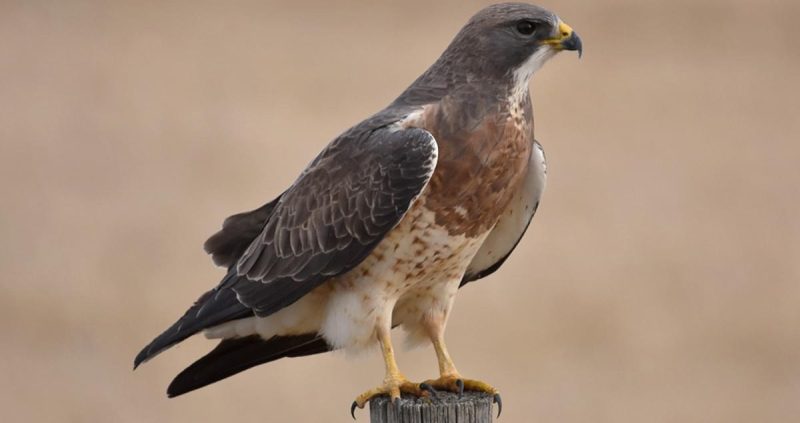
Swainson’s Hawk is a long-winged raptor that frequents Wyoming’s open grasslands and agricultural regions. Measuring between 18 to 22 inches in length with a wingspan of 46 to 54 inches, this hawk is slightly smaller and slimmer than the Red-tailed Hawk. Adults typically have a light underside with a distinctive dark bib across the chest, while their long, pointed wings help distinguish them in flight. Dark-morph individuals are entirely brownish but still retain pale flight feathers that contrast against their darker body.
These hawks are highly migratory, traveling thousands of miles each year from breeding grounds in North America to wintering areas in Argentina. In Wyoming, they are a common summer resident, arriving in spring to breed before departing southward in late summer. Their flight behavior is graceful, often involving gliding and soaring over open country, making them a familiar sight to those driving through Wyoming’s vast prairies.
Swainson’s Hawks have a varied diet that changes with the seasons. During the breeding season, they primarily hunt small mammals, reptiles, and birds to feed their young. However, outside of the nesting period, they shift to an insect-heavy diet, consuming grasshoppers, crickets, and locusts in large numbers. Their tendency to gather in large flocks while foraging makes them important biological pest controllers in agricultural areas of Wyoming.
Nesting usually occurs in trees or shrubs near grasslands and farmland, with pairs constructing bulky stick nests lined with softer vegetation. They typically lay two to three eggs, which are incubated for about a month. Both adults share responsibilities in rearing chicks, and fledging occurs at around six weeks. Their distribution in Wyoming is widespread in open plains and prairies, particularly in the eastern and central regions, where expansive agricultural fields provide suitable hunting and nesting opportunities.
Ferruginous Hawk
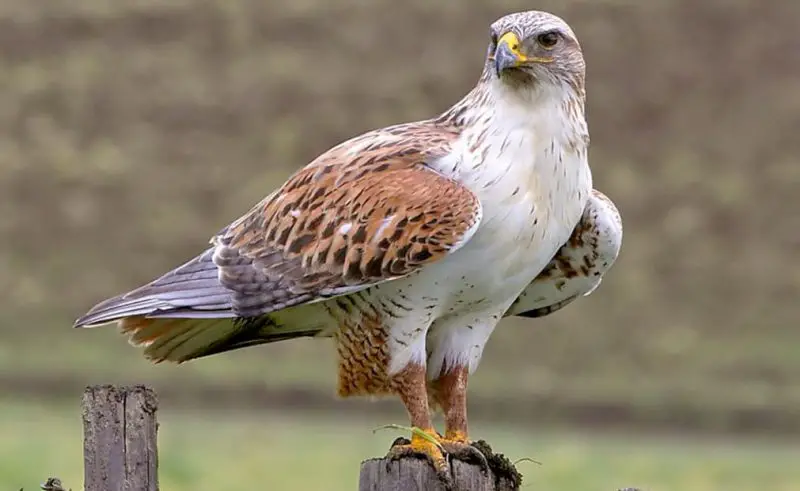
The Ferruginous Hawk, the largest hawk in North America, is an impressive raptor found in Wyoming’s wide-open country. Adults measure 22 to 27 inches in length with wingspans reaching 55 to 60 inches, and they can weigh up to 4 pounds. They are named for their rust-colored legs and wing feathers, which contrast with their pale underparts and white tail. In flight, their long, broad wings and large size help distinguish them from other hawks in the region.
Behaviorally, Ferruginous Hawks are powerful hunters that prefer low, soaring flights over open plains where prey is abundant. They are less likely to perch in trees than other hawks, instead favoring ground perches such as fence posts or rock outcroppings. They often use cooperative hunting strategies when food is plentiful, sometimes gathering in groups to prey on rodents in fields. Their calm demeanor makes them approachable for observation, although they can become defensive near their nests.
Their diet is dominated by small to medium-sized mammals, particularly prairie dogs, ground squirrels, and jackrabbits. They are capable of tackling larger prey than most hawks, occasionally preying on snakes and birds. By regulating populations of burrowing mammals, Ferruginous Hawks play a key ecological role in maintaining balance in Wyoming’s grassland ecosystems.
Ferruginous Hawks breed in open country, building large nests on cliffs, trees, or even on the ground when elevated sites are unavailable. Clutches usually contain two to four eggs, incubated primarily by the female, while the male provides food. Nesting sites are often reused for several years. In Wyoming, they are found in grasslands, sagebrush steppes, and desert plains, with populations particularly concentrated in areas where prairie dog colonies are abundant.
Rough-legged Hawk
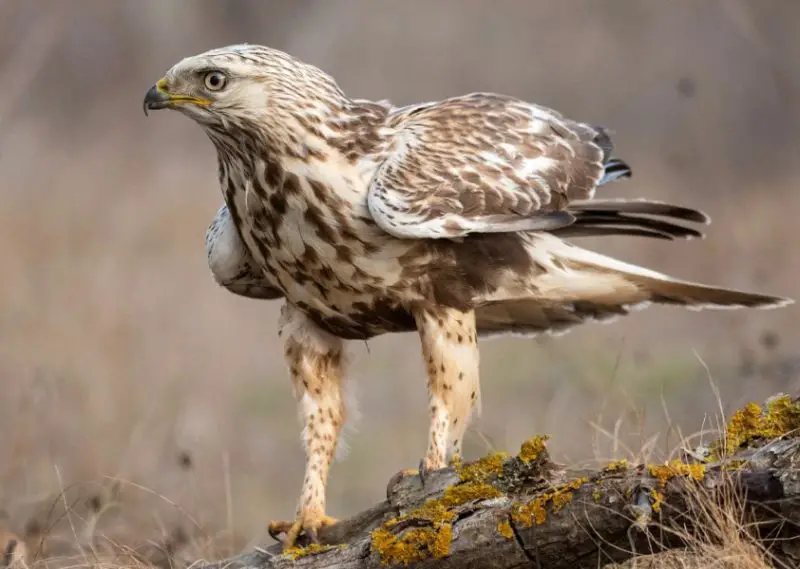
The Rough-legged Hawk is a striking winter visitor to Wyoming, migrating south from Arctic breeding grounds. Measuring 18 to 23 inches in length with a wingspan of 52 to 54 inches, it is similar in size to the Red-tailed Hawk but can be identified by its feathered legs, which help insulate against cold climates. Adults show distinct plumage variations, with light morphs having pale underparts and dark belly patches, while dark morphs appear much darker overall.
Unlike most hawks, Rough-legged Hawks are highly adapted for hovering flight. They often face into the wind and hover in place while scanning for prey, a behavior more commonly seen in kestrels. This hovering ability allows them to hunt efficiently in Wyoming’s open fields and prairies during the winter months. Their movements are graceful yet methodical, as they rely on sight to detect rodents beneath the snow.
Their diet in Wyoming consists mainly of small mammals such as voles, mice, and lemmings, though they will also take rabbits and birds when available. They typically hunt from perches or while hovering, swooping down quickly to seize prey. Unlike Red-tailed Hawks, Rough-legged Hawks rarely scavenge, instead relying on live prey to sustain themselves during the cold months.
Breeding occurs far north in the Arctic tundra, where they nest on cliffs and rocky outcrops. By the time they reach Wyoming, they are not breeding but spending the winter in open habitats such as grasslands, shrub-steppe, and agricultural fields. Their distribution across the state varies yearly depending on rodent populations, making them an exciting yet irregular visitor for Wyoming birdwatchers.
Northern Harrier

The Northern Harrier is a slim, medium-sized raptor with a distinctive hunting style that makes it stand out across Wyoming’s wetlands, grasslands, and prairies. Adults measure 18 to 20 inches long with a wingspan of 40 to 46 inches, and they are easily recognized by their long wings, long tail, and characteristic white rump patch visible in flight. Males are pale gray above and whitish below, earning them the nickname “Gray Ghost,” while females and juveniles are brown with streaked underparts.
These hawks are unique in their hunting behavior, flying low over fields with a buoyant, owl-like flight as they listen and watch for prey. Unlike most raptors, Northern Harriers rely heavily on hearing as well as sight, aided by their facial disk of feathers that functions similarly to owls. This adaptation allows them to detect small mammals moving in dense grass or under snow, making them effective hunters in Wyoming’s open habitats.
Their diet consists primarily of voles, mice, and other small mammals, although they will also take birds, reptiles, and insects. Harriers typically kill prey by grasping it with their talons after a sudden pounce. They are also known to pirate food from other raptors when opportunities arise. This opportunistic feeding behavior enables them to survive in areas where prey availability fluctuates.
Breeding usually occurs in marshes and grasslands, where females build ground nests concealed among tall vegetation. Clutches average four to six eggs, and males may mate with multiple females, providing food to more than one nest during the breeding season. In Wyoming, Northern Harriers are seen year-round but are most abundant during the breeding season in summer. They favor wetlands, prairies, and agricultural areas, where tall grasses and open fields support both nesting and hunting activities.
Cooper’s Hawk
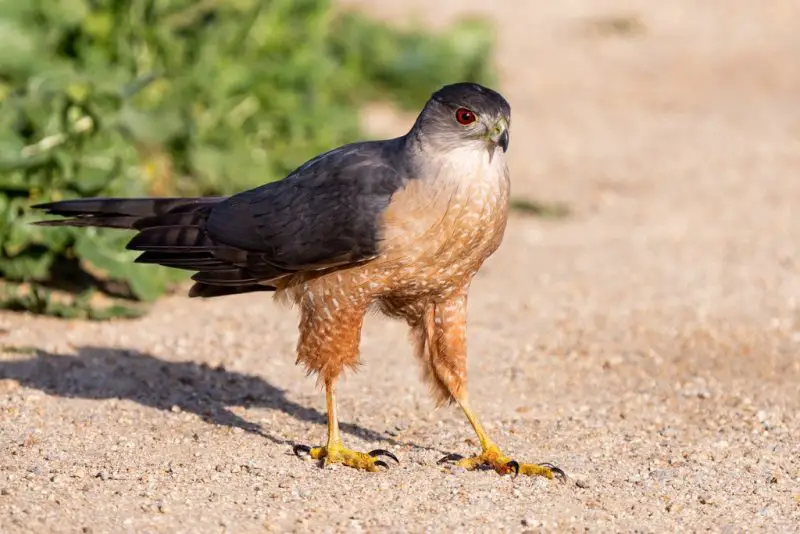
Cooper’s Hawk is a medium-sized raptor that belongs to the Accipiter group, well known for its swift, agile hunting style. Adults typically measure 14 to 20 inches in length with a wingspan of 24 to 36 inches, and females are considerably larger than males. They have a long, rounded tail with dark bands, short rounded wings, and a sleek body built for maneuverability. Adults display bluish-gray upperparts with rufous barring on the chest, while juveniles are brown above with streaked underparts.
These hawks are masters of surprise, using stealth and speed to capture prey within dense cover. Unlike soaring buteos, Cooper’s Hawks often fly low and fast through trees, twisting skillfully in pursuit of their quarry. They are secretive birds, often going unnoticed until they suddenly burst into action. In Wyoming, they are seen year-round, especially near woodlands, riparian corridors, and even urban areas where prey is abundant.
Their diet is dominated by birds, including pigeons, doves, and songbirds, though they also hunt small mammals such as squirrels and chipmunks. They typically ambush prey with a rapid dash and seize it with powerful talons, sometimes even pursuing birds into backyards and bird feeders. Their role as a predator of small birds can create conflicts with humans, but they are essential for maintaining balanced populations of common avian species.
Breeding occurs in forested areas, with nests built high in trees from sticks and lined with softer vegetation. Females lay three to five eggs, incubating them for about a month while the male provides food. Both parents feed the young until they fledge after about five weeks. In Wyoming, Cooper’s Hawks are found throughout wooded habitats, thriving both in natural forests and suburban landscapes that provide plentiful food and shelter.
Sharp-shinned Hawk
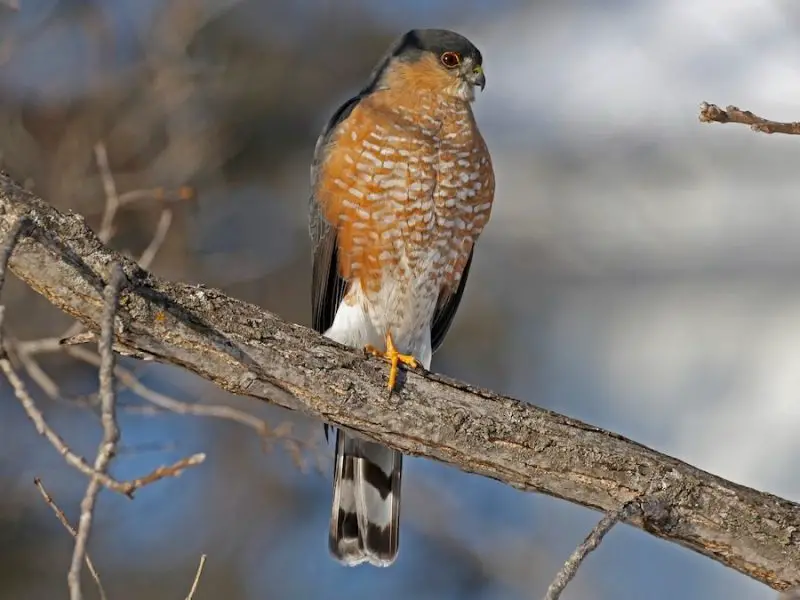
Sharp-shinned Hawks are the smallest accipiters in North America and can be found across Wyoming, especially during migration. They measure 9 to 13 inches long with wingspans of 17 to 22 inches, making them similar in size to a jay. Adults have bluish-gray upperparts with orange barring across the chest, while juveniles are brown above with streaked underparts. Their long, narrow tails with squared-off tips and short, rounded wings are key features for identification.
These hawks are incredibly agile flyers, darting swiftly through dense vegetation in pursuit of small songbirds. They are often seen during spring and fall migration when they pass through Wyoming in significant numbers, sometimes joining mixed flocks of migrating raptors. Their flight is characterized by several quick wingbeats followed by short glides, a typical pattern of accipiters.
Their primary prey is small birds, which they ambush in wooded habitats, at forest edges, or near bird feeders. They rely on surprise and rapid pursuit to capture prey, often striking with deadly precision. Though they mainly consume birds, Sharp-shinned Hawks occasionally hunt small mammals and large insects. By preying on numerous small songbirds, they influence local bird populations and are considered vital predators in forest ecosystems.
Breeding occurs farther north or in mountainous regions, where they construct nests in coniferous or mixed forests. Females typically lay four to five eggs, incubated for about 30 days. After hatching, the young remain in the nest for several weeks, relying on both parents for food. In Wyoming, Sharp-shinned Hawks are most frequently encountered during migration or in higher elevation forests during the summer.
Northern Goshawk
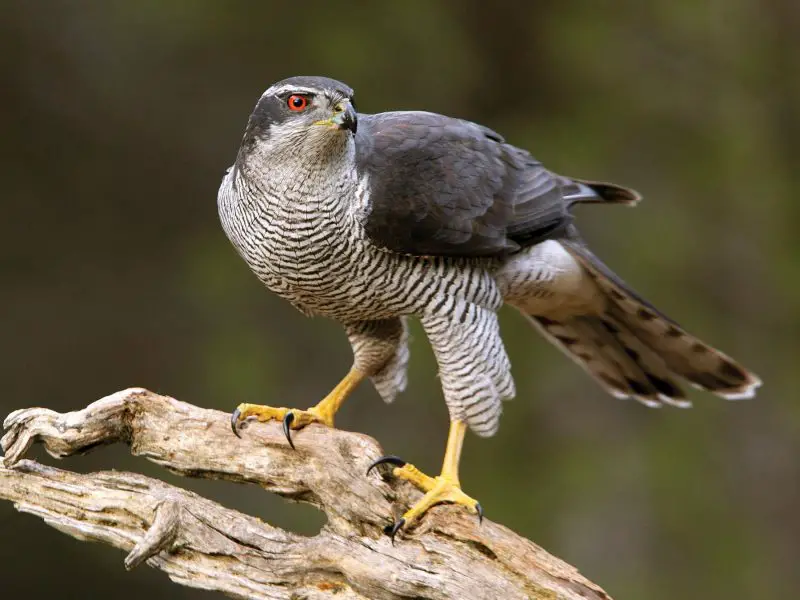
The Northern Goshawk is the largest of the North American accipiters and is a powerful raptor found in Wyoming’s forests. Adults measure 20 to 26 inches long with wingspans of 40 to 46 inches, and they possess broad wings with a long, rounded tail. Their plumage is striking, with dark gray upperparts, finely barred underparts, and a bold white stripe over piercing red eyes. Juveniles are brown with heavy streaking below.
This hawk is a fierce and aggressive hunter, capable of chasing down prey through dense woodlands with remarkable agility. Known for its strength and persistence, the Northern Goshawk often ambushes prey with explosive bursts of speed, navigating between trees with ease. They are also highly territorial and will aggressively defend their nesting areas, even attacking humans who venture too close.
Their diet is diverse, including medium-sized birds such as grouse, crows, and jays, as well as mammals like rabbits, hares, and squirrels. They hunt both from perches and during active flight, striking prey with immense force. This varied diet allows them to thrive in Wyoming’s forested mountain ranges, where prey availability shifts with the seasons.
Breeding takes place in mature forests, with nests built high in large conifer or deciduous trees. Nests are bulky structures of sticks, often reused and added to over years. Clutch sizes usually contain two to four eggs, which hatch after about a month of incubation. In Wyoming, Northern Goshawks are most often found in mountainous and forested regions, particularly in the Bighorn, Medicine Bow, and Teton ranges.
Broad-winged Hawk
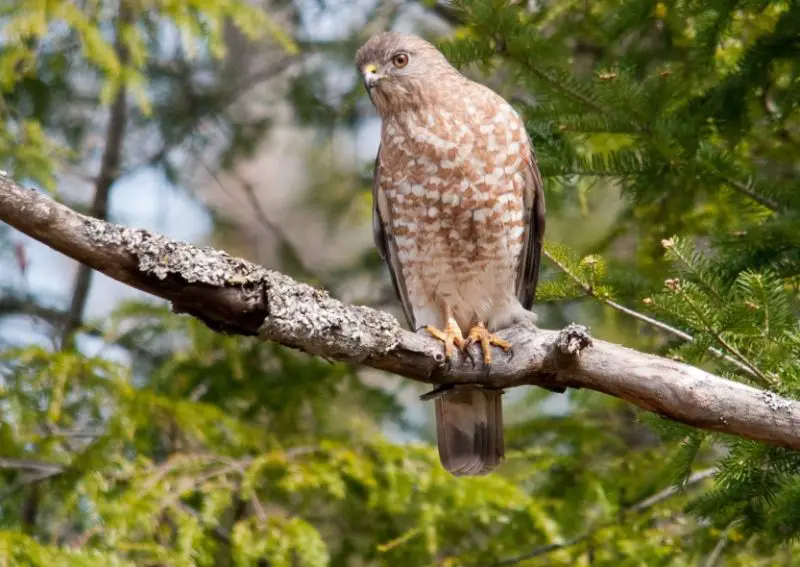
Broad-winged Hawks are small buteos that migrate through Wyoming, though they are less common than other hawk species in the state. They measure 13 to 17 inches long with wingspans of 32 to 40 inches. Adults are dark brown above with barred underparts and a tail marked by broad black and white bands. Their stocky build and broad wings with pointed tips make them well-suited for soaring during migration.
During migration, Broad-winged Hawks are famous for forming massive flocks called “kettles,” where hundreds or even thousands of birds circle upward on thermals before gliding southward. In Wyoming, they are mainly seen in the spring and fall as they pass through, often traveling over mountain ridges and valleys. Their flight is powerful yet buoyant, relying heavily on thermals for long-distance travel.
Their diet consists primarily of small mammals, amphibians, reptiles, and insects. They are versatile hunters that often perch silently on branches before swooping down to capture prey. During the breeding season in other parts of North America, they also feed on nestling birds and small rodents. Though less common in Wyoming than in eastern states, they still play an important role as seasonal predators.
Broad-winged Hawks nest in deciduous or mixed forests, building stick nests high in trees. Clutches usually consist of two to three eggs, incubated mainly by the female while the male provides food. Since Wyoming lies on the edge of their range, nesting records are scarce, but migrants are observed consistently. Their presence in Wyoming highlights the state’s role as a migratory corridor for numerous raptor species.
Harris’s Hawk
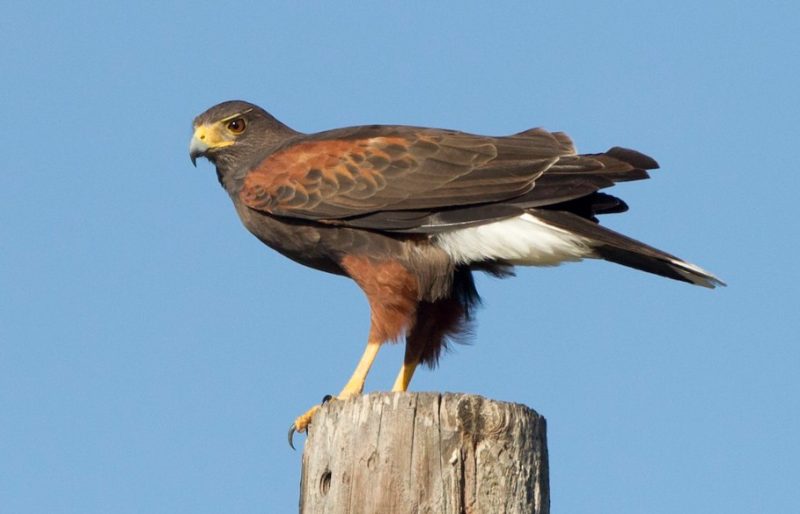
Harris’s Hawk is a distinctive raptor known for its social hunting behavior, which is unusual among hawks. Measuring 18 to 24 inches long with wingspans of 40 to 47 inches, these hawks are easily recognized by their dark brown plumage, chestnut shoulders and thighs, and white-tipped tail. Their long legs and sleek build give them an elegant appearance in flight and on the ground.
One of the most remarkable aspects of Harris’s Hawks is their cooperative hunting style. Unlike most raptors that hunt alone, these hawks often hunt in family groups, coordinating to flush and capture prey. This pack-like strategy increases hunting success and allows them to tackle larger prey. Though they are more common in the southwestern United States, occasional sightings occur in Wyoming, especially in the southern regions.
Their diet includes rabbits, hares, rodents, and birds, with groups working together to surround prey. They are also known to scavenge opportunistically. Their intelligence and adaptability have made them a favorite among falconers, further adding to their reputation as one of the most unique raptors in North America.
Breeding usually occurs in desert or semi-arid regions, where they nest in trees, shrubs, or cacti. Clutch sizes typically include two to four eggs, and cooperative breeding is common, with multiple adults helping to raise chicks. In Wyoming, Harris’s Hawks are rare visitors, more often seen in open habitats near the state’s southern border. Their presence is considered unusual, adding excitement for birdwatchers who spot them.
Zone-tailed Hawk
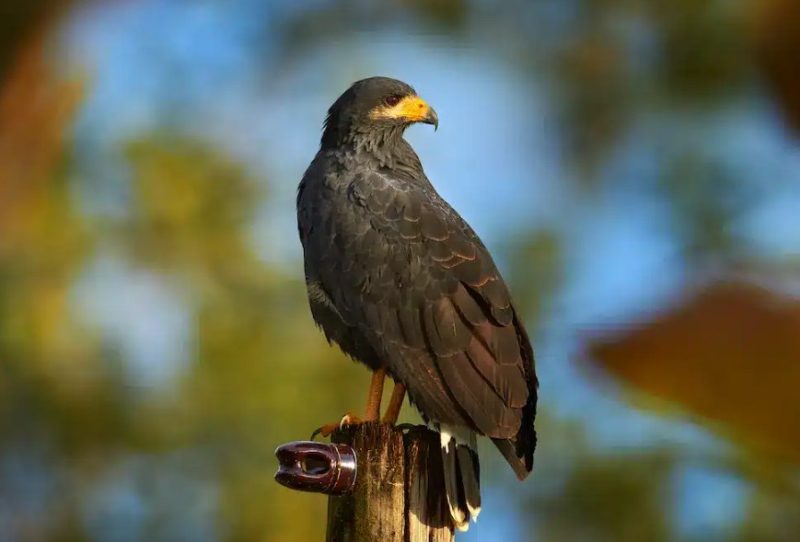
The Zone-tailed Hawk is a striking raptor often mistaken for a Turkey Vulture due to its similar flight style and appearance. Adults measure 18 to 22 inches long with wingspans of 46 to 55 inches. They are mostly black with a few white bands on the tail, which gives the species its name. Their broad wings and buoyant soaring flight further enhance their resemblance to vultures, a form of mimicry that helps them approach prey unnoticed.
These hawks fly with wings held in a shallow “V,” rocking slightly in the wind, almost identical to the flight pattern of Turkey Vultures. This mimicry allows them to blend in with vulture flocks, gaining the advantage of stealth while hunting. Though they are more common in the southwestern United States, Zone-tailed Hawks occasionally reach southern Wyoming, where they are considered rare but possible breeders in suitable habitats.
Their diet consists of small mammals, birds, reptiles, and amphibians. Unlike vultures, which feed on carrion, Zone-tailed Hawks actively hunt live prey. They often patrol low over open country, scanning the ground before diving swiftly to capture animals. Their hunting success is aided by their vulture-like disguise, which prevents prey from recognizing them as predators until it is too late.
Breeding occurs in canyons, cliffs, and rugged terrain, where they build nests of sticks lined with green vegetation. Clutches usually contain one to three eggs, incubated mainly by the female. In Wyoming, sightings are rare and localized, mostly in the southern and western regions near rocky canyons. Their secretive habits and resemblance to vultures make them one of the more easily overlooked hawks in the state.
FAQs About Hawks in Wyoming
What types of hawks can be seen in Wyoming?
Wyoming is home to a wide variety of hawks, including Red-tailed Hawks, Swainson’s Hawks, Ferruginous Hawks, Rough-legged Hawks, and Northern Harriers. Other species such as Cooper’s Hawks, Sharp-shinned Hawks, Northern Goshawks, Broad-winged Hawks, Harris’s Hawks, and Zone-tailed Hawks can also be found in certain regions or during migration.
When is the best time to see hawks in Wyoming?
Many hawks can be seen year-round in Wyoming, such as Red-tailed Hawks, Northern Harriers, and Cooper’s Hawks. Migratory species like Swainson’s Hawks and Broad-winged Hawks are best observed in spring and fall. Rough-legged Hawks are common winter visitors, while Zone-tailed and Harris’s Hawks are rare but possible in the southern parts of the state.
What habitats do hawks prefer in Wyoming?
Hawks in Wyoming occupy a wide range of habitats. Grasslands, prairies, and sagebrush flats attract Swainson’s and Ferruginous Hawks, while forests and mountains provide homes for Northern Goshawks and Cooper’s Hawks. Wetlands and marshes are favored by Northern Harriers, and open country with cliffs or canyons can host rarer species like the Zone-tailed Hawk.
What do hawks eat in Wyoming?
The diet of hawks in Wyoming depends on the species. Most feed primarily on small mammals such as voles, rabbits, and squirrels. Others, like Cooper’s and Sharp-shinned Hawks, specialize in hunting smaller birds. Northern Harriers rely on both sight and hearing to capture rodents, while Ferruginous Hawks are capable of taking larger prey, including prairie dogs and jackrabbits.
Do hawks migrate through Wyoming?
Yes, several hawk species migrate through Wyoming. Swainson’s Hawks travel thousands of miles to South America for the winter, and Broad-winged Hawks pass through the state in large flocks during migration. Rough-legged Hawks arrive from the Arctic each winter, while resident species such as Red-tailed Hawks and Northern Harriers remain in Wyoming year-round.
Are hawks dangerous to humans or pets in Wyoming?
Hawks are not considered dangerous to humans, though species like Northern Goshawks may aggressively defend nests if people get too close. Small pets such as kittens, small dogs, or backyard poultry could occasionally be at risk from larger hawks, but such incidents are rare. Hawks play an essential role in maintaining healthy ecosystems by controlling rodent and bird populations.
Where are the best places to go hawk-watching in Wyoming?
Some of the best places to observe hawks in Wyoming include open prairies, sagebrush flats, river valleys, and mountainous forests. Areas such as Yellowstone National Park, Grand Teton National Park, and the Bighorn Mountains provide excellent viewing opportunities. During migration, ridgelines and wide valleys are ideal spots for spotting soaring hawks.

